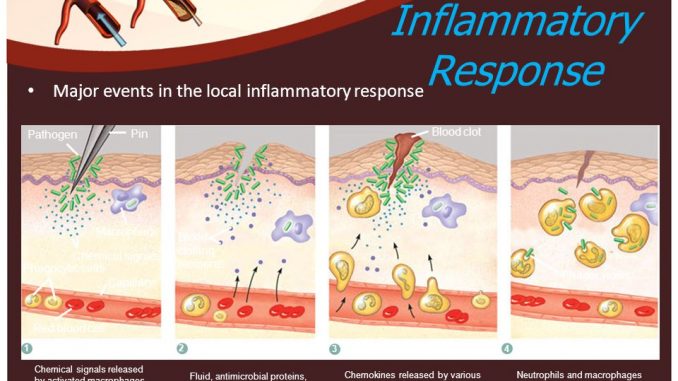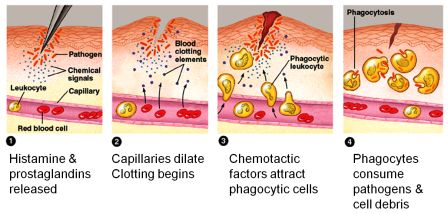
Inflammation or Inflammatory barrier of immune system
- Inflammation is an important defense mechanism of host to prevent infection. It is induced in response to tissue damage caused by microorganism, toxins or by mechanical means.
- The inflammation may be acute; for eg. in response to tissue damage or chromic; for eg. Arthritis, cancer etc.
- Main aim of inflammation is to prevent spread of injected microorganism or toxin from site of injection and kill them on spot by phagocytosis.
Characteristics of inflammation:
- Rubor: redness
- Tumor: swelling
- Calor: heat
- Dolor: pain
- Functio laesa: loss of function
Steps of inflammatory response

Step I: Tissue damage and Release of histamine:
- Tissue damage caused by toxin, microorganism or mechanical injury release histamine.
Step II: Vasodilation:
- Histamine acts on surrounding blood capillaries and causes vasodilation.
- When vasodilation occurs, speed of blood flow decreases so that Neutrophils get chance to settle at the site of infection.
Step III: Increased permeability:
- At the same time histamine increases the permeability of blood capillaries leading to leakage of fluid from blood capillaries. This results in accumulation of fluid causing edema.
Step IV: Extravasation:
- Within few hours, Neutrophil migrates to the site of tissue damage by the process of chemotaxis and passes through capillaries wall and enter into tissue space by the process called extravasation.
- Extravasation completes in 4 steps:
- Rolling: neutrophils attach loosely to endothelium by low affinity interaction between glycoprotein-mucin of Neutrophil.
- Activation of chemotactic stimus: chemokines are secreted and Neutrophil are attracted.
- Arrest and adhesion: ICAMS and integrin stabilize adhesion of neutophil and endothelium
- Transendothelial migration: Neutrophil enter through endothelium layer.
Step V: Phagocytosis:
- Neutrophil kills the injected microorganism or toxins by phagocytosis and release molecular mediators that contributes to inflammatory response. At the same time activates effectors cells.
Step VI: Inflammatory response:
- As inflammatory response develops, various cytokines and other inflammatory mediators act on endothelium of local blood vessels, including increased expression of cell adhesion molecules (CAMs). The epithelium is then said to be inflamed.
- Neutrophils are the first cell types to bind to inflamed endothelium and extravasate into tissue.

Well understanding notes but not explain briefly about the objective. So sir mention briefly plz but nice notes.